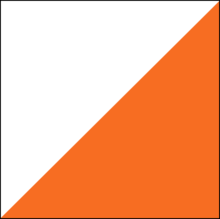Orienteering
Orienteering is a group of sports that require navigational skills using a map and compass to navigate from point to point in diverse and usually unfamiliar terrain whilst moving at speed. Participants are given a topographical map, usually a specially prepared orienteering map, which they use to find control points. Originally a training exercise in land navigation for military officers, orienteering has developed many variations. Among these, the oldest and the most popular is foot orienteering. For the purposes of this article, foot orienteering serves as a point of departure for discussion of all other variations, but almost any sport that involves racing against a clock and requires navigation with a map is a type of orienteering.
Orienteering is included in the programs of world sporting events including the World Games.
Contents
History
The history of orienteering begins in the late 19th century in Sweden, the actual term "orientering" (the original Swedish name for orienteering, lit. "orientation") was first used in 1886 at the Swedish Military Academy Karlberg and meant the crossing of unknown land with the aid of a map and a compass.[1] In Sweden, orienteering grew from military training in land navigation into a competitive sport for military officers, then for civilians. The name is derived from a word root meaning to find the direction or location. The first civilian orienteering competition open to the public was held in Norway in 1897, when Norway was still a part of the Swedish union.
From the beginning, locations selected for orienteering have been chosen in part for their beauty, natural or man-made. For the first public orienteering competition in Sweden, in 1901, control points included two historic churches, Spånga Church and Bromma Church (a round church) With the invention of inexpensive yet reliable compasses, the sport gained popularity during the 1930s. By 1934, over a quarter million Swedes were participants, and orienteering had spread to Finland, Switzerland, the Soviet Union, and Hungary. Following World War II, orienteering spread throughout Europe and to Asia, North America and Oceania. In Sweden in 1959, an international orienteering conference was held. Representatives from 12 countries participated. 1961, orienteering organizations representing 10 European nations founded the International Orienteering Federation (IOF). Since then, IOF has supported the founding of many national orienteering federations. By 2010, 71 national orienteering federations were member societies of the IOF. These federations enabled the development of national and world championships. World championships were held every two years until 2003, then every year. Throughout this time, orienteering has remained most popular in Scandinavia. There, the two oldest recurring orienteering meets have been held since the 1940s (Jukola relay and Tiomila), and the single largest orienteering meet has been held every year since 1965 and attracts around 15,000 competitors (O-Ringen).
Typically, orienteering is run in wild terrain. In its Scandinavian origins, this typically meant in the forest, but orienteering in open fell, heathland, moorland and other mixed terrain is also common. Orienteering in towns has been common for many years. Street-O has typically been a low-key affair; score events, often at night, normally as informal training events. The Venice street-O is notable for attracting a large international participation. With Park World Tour races and other (e.g. World championships) elite sprint races often being held in urban areas, and the development of a map specification for urban areas (ISSOM), from the mid-2000s, Street-O has been rebranded as urban orienteering, and has taken itself rather more seriously, with full colour maps and electronic punching, and may now be regarded as a serious competition with inclusion in national ranking lists. Such urban races are often much longer than the sprint distance.
Competition types
Orienteering events can be classified in many different aspects:
- By method of travel: FootO, SkiO, Mountain bike orienteering (MTBO), etc.
- By the length: sprint, middle, long
- By the time the competition was held: day, night
- By the number of competitors: individual, team, relay
- By the visiting order of controls: cross-country (in a specific order), score (free to decide order)
Long
Classic orienteering involves a race between controls in a preset order. The winner is the person who completes the course in the shortest time. This is called a "cross-country" course as distinct from a score course (see below). Courses are normally designed so that the fastest route is not straightforward to find on the map, or to follow on the ground. The classic race has a typical winning time of 75–90 minutes. As of 2007, the IOF have dictated that the "classic" course should be redesignated the "long".
Middle
The middle distance is a shorter cross-country race than the classic (or long), with a winning time in the region of 30 minutes and with an emphasis more on fine navigation than route-choice. When races of this distance were run in the mid-late 1990s, they were called "short" races, or "sprint-O". The short distance was introduced as a world championship discipline in 1991. More recently, though the IOF have renamed this distance as "middle".
Relay
A relay race is run by a team of competitors each running a course, and the result is based on the team's total time. Relays usually employ a mass start instead of a staggered start. Relays are part of World Orienteering Championships both as sprint relays and as cross-country relays. Additionally, there are popular mass club races out of which Jukola relay has the highest number of participating clubs 1,787 (in 2015), while 25-manna has the highest number of legs 25. To reduce competitors following each other, various spreading methods might be used. This is called "gaffling", which is a Swedish word meaning "forking". The key principle is that every team must run every leg (between each pair of two controls), but not necessarily in the same order. The IOF have introduced the nomenclature to try to clarify the usage of the word "leg". In orienteering usage, leg normally refers to the part of a race between two control points. In relay (non-orienteering) usage, leg refers to the part of a race run by a single team member. The IOF prefer "lap" for this latter term, but despite this, in common parlance, "leg" is used for both terms.
Score
Competitors visit as many controls as possible within a time limit. There is usually a mass start (rather than staggered), with a time limit. Controls may have different point values depending on difficulty, and there is a point penalty for each minute late. The competitor with the most points is the winner. The large-scale, endurance-style version of a Score-O is known as a rogaine, competed by teams in events lasting (often) 24 hours. A very large area is used for competition, and the map scale is smaller. The format originated in Australia. The term ROGAINE is often said to stand for Rugged Outdoor Group Activity Involving Navigation and Endurance; this is essentially a backronym, as the name actually originates from the names of Rod, Gail and Neil Phillips, who were among Australian Rogaining's first participants
Sprint
Very short races, with winning times in the region of 12–15 minutes, often held in city parks and other more urban settings. Map scales are usually 1:5,000 or 1:4,000. Control sites can include benches, litterbins, sculptures, and other objects common to urban parks.[2] The sprint distance may also be held in the forest, when it would be called a "forest sprint" as opposed to an "urban sprint". This distance was pioneered in the late 1990s as an elite event by the Park World Tour organisation who organised an independent "world cup" in park sprint orienteering. In 2001 in Tampere, the IOF included a sprint distance in the orienteering world championships.
Ultrasprint
Ultrasprint events are held in a specially constructed labyrinth. Due to the limited area of the labyrinth, ultrasprint is a more spectator-friendly form of orienteering. Also, as the course is artificial, identical courses can be set in different geographical locations for simultaneous local competitions as parts of a larger tournament.[3][4]
Night
Competitors use a headlamp to navigate in the dark. Reflective markers often are used on control point flags, which shifts the tactics from precision navigation to searching. Competitors can travel at high speed to the vicinity of the control point, then sweep the area with the light to catch a reflection off the control flag. If a night event starts before dark, a mass start must be used so all competitors have equal time in the light and dark. The two classic club relays, Tiomila and Jukola, both include night legs. Full length (24-hour) rogaines and many adventure races run through the night, without a light period, and competitors may choose not to rest.
String
Competitors follow a string around a short course, noting down things that they find on the way. This is generally used by young children and people new to the sport who want to find out what it is like.
Precision
Precision orienteering generally is not a speed event, but rather a test of the competitors' ability to precisely match map and terrain. Examples include trail orienteering (trail-O) (untimed), TREC style mounted orienteering, and Radio Orienteering in a Compact Area (ROCA). Both trail-O and ROCA use decoys in the vicinity of the control point.
Source
- This is an excerpt from the wikipedia Orienteering page.

